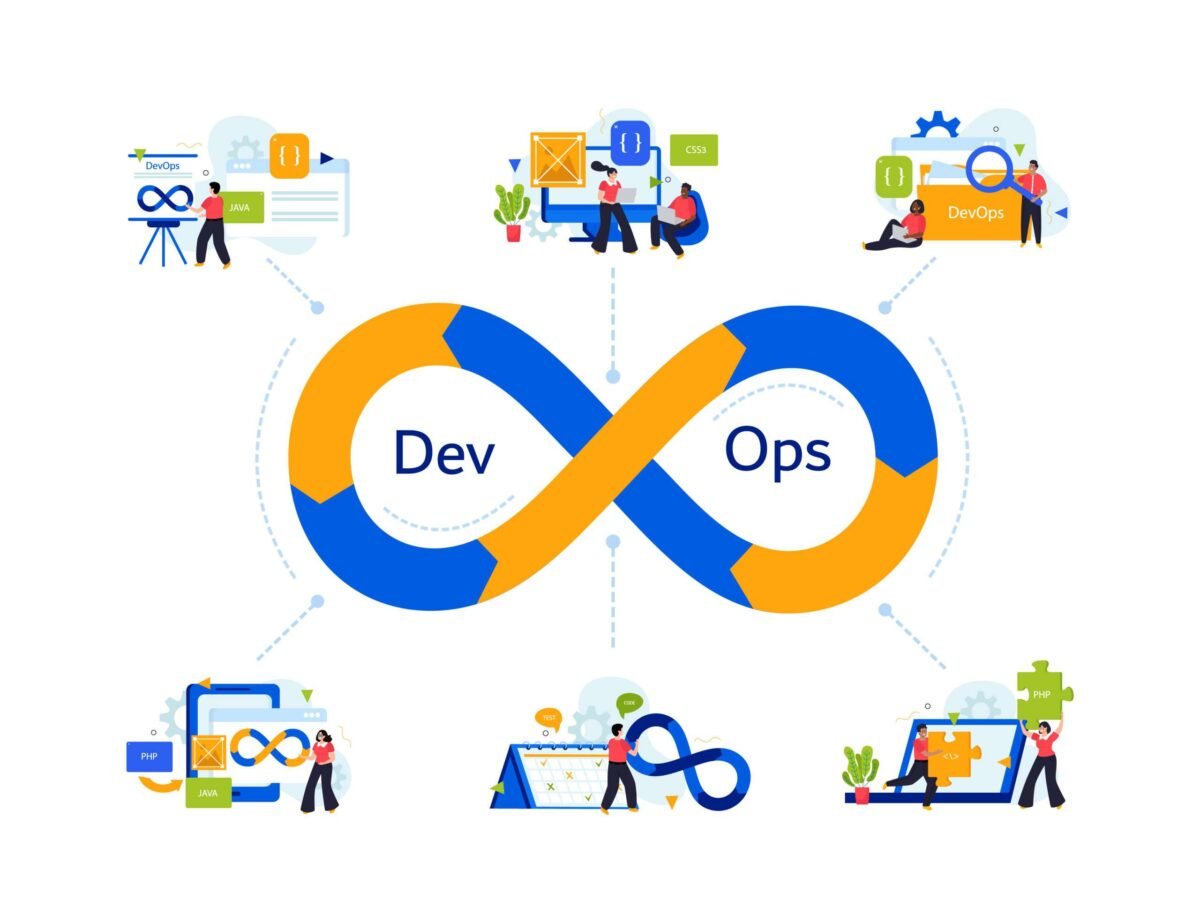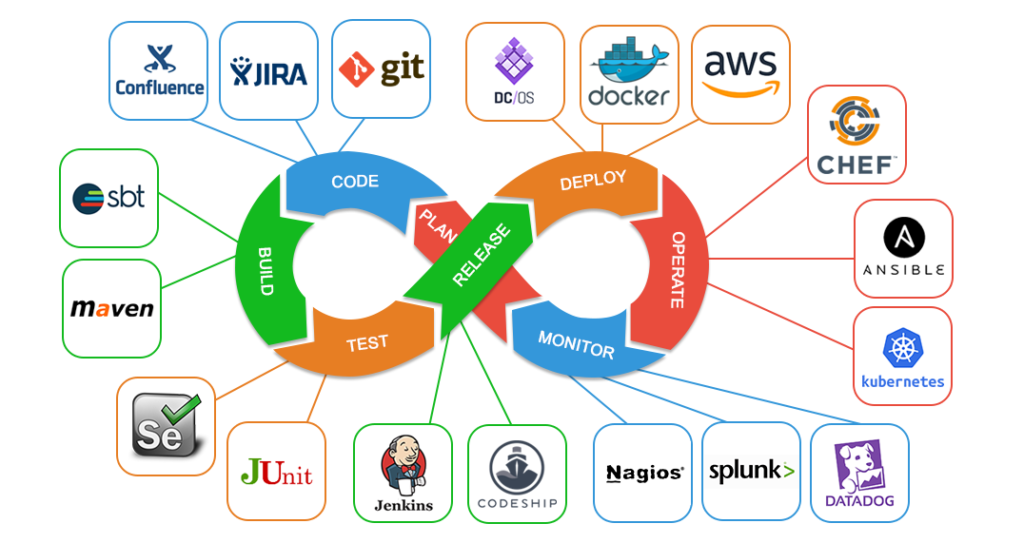
One of the concepts frequently used by those working in software development is DevOps. DevOps can be expressed as an abbreviation created by combining the words Development and Operations. The person who created the concept of DevOps by combining the words Development and Operations is Patrick Debois. Debois, himself a web developer, introduced the concept of DevOps in 2009.
DevOps refers to teamwork where all programming processes are carried out from the beginning of design to development processes. DevOps also refers to all of the tools and philosophies that increase the highest level of efficiency and finalization capabilities of teams working in the field of Information Technology (IT).
A DevOps programmer uses basic infrastructure management and software development processes. DevOps takes an Agile approach to software development.
Explanations of DevOps and Agile
The concept and principles of DevOps are an evolution in IT. At this point, it is very important to know the technical content and principles of DevOps. In order to define the concept of DevOps, it is also necessary to be familiar with Agile development. Agile, also known as “Agile / Agile Software Development”, refers to the general name of software development methods that include simpler principles.
These methods guide project managers through the well-known and frequently used audit and compliance processes. Agile development loses its efficiency without DevOps principles. In general terms, Agile is a special approach to project management in software development processes.
The Agile method helps teams with the unpredictable situations they experience in software development processes. In the Agile method, work sequences called “Sprints”, which include iterations and increments, are frequently used. Agile methodology can be integrated into the business processes of corporate structures and web developers. The term Sprint used in Agile methodology refers to the time allocated to a specific phase in a specific project. When the sprint expires, this indicates the completion of the project.
What are DevOps Principles?
System administrators are of great importance in the creation phase of DevOps development. DevOps therefore encompasses enterprise system administrations and practices at the highest level. Some of the applications in DevOps processes include dynamics such as automation and system monitoring to increase the efficiency of the software development process. DevOps principles are addressed at 3 basic levels. These are
- Human Factors and Cultures
- Practices and Processes
- Technology and Tools
The first of the DevOps principles, human factors and cultures, refers to breaking down the barriers that have developed or are likely to develop between teams within a given organization. DevOps helps the existing team to work together towards a common goal.
The aim of this principle is to deliver software to the customer as quickly and with as high quality as possible. DevOps and Agile methods work together on the principle of practices and processes. Companies anticipate the processes that will come with the adoption of additional automation such as Agile and Scrum. This principle also regulates the ways in which processes can be renewed.
The principle of technology and tools emphasizes the right choice of tools and technology in the use of the DevOps method. Because without the ideal use of tools and technology, DevOps cannot offer a sustainable flow. All of these enable automations, integrations, configuration management, testing, release and deployment.
Working with DevOps for Beginners
For those who have no previous experience of working with DevOps, one of the main questions is how a sustainable software development process works. One of the most critical components of DevOps is automation. In the simplest terms, automation can be defined as the division of a certain process between the human factor and machines.
When using DevOps, software development processes need to be connected to different tasks and different tools. DevOps is not an aggregation tool, but a set of methods that have a working systematic within itself. Due to the Agile approach within DevOps, users integrate their existing work with the work of other programmers.
This cycle is continuous and supports the elimination of problems that may arise during the process. When working with DevOps, users can test the code they have written with the help of different automation tools. The testing phase is one of the most functional aspects of DevOps. Because it allows to shorten the project processes significantly. Eliminating individualism and teamwork while working with DevOps goes against the principles and logic of DevOps. The success of working with DevOps depends on the cooperation between all team members involved in a particular project.
What are the Advantages of DevOps?
With the DevOps approach, operations and development processes are much more collaborative. The team members involved in the projects progress more consciously towards the goals set with DevOps. The prominent advantages of DevOps are as follows.
Fast Project Delivery
With DevOps, it is possible to develop a new product much faster. Implementing new features in development processes, making bug fixes in a short time, identifying the needs of customers and moving in that direction are easily managed with DevOps. Automating software release processes and all other dynamics ensure faster delivery of projects with DevOps.
Security System
When working with DevOps, you don’t have to compromise on controls and compliance standards. Security systems operate at the highest level with the automation of compliance policies, detailed audits, and configuration management techniques. In the DevOps model, codings and code policies ideally define the compliance situations. With DevOps, all processes can be monitored and security vulnerabilities can be identified specifically and intervened immediately.
Reliability Feature
When working with DevOps, updates to applications and changes to infrastructures are created with reliable methods. Delivering projects in the most secure way and keeping user experiences at the highest level is possible with DevOps. In automation and integration processes, the reliability of each change can be measured with the help of the applications used. Application performances can be monitored at each stage of the processes.
Scaling Feature
With DevOps, it is easy to scale and manage the development processes of project infrastructures. Automations, consistencies help to make more complicated or variable systems efficient. DevOps scaling also makes it easier to manage existing or potential risks. The use of infrastructure models of code makes development, testing and production efficient, enabling sustainable success.
Speed Factor
When working with DevOps, it is possible to move at very high speeds and develop faster innovations for customers. This feature of DevOps enables better results by strengthening the ability to adapt to changing market spaces. The DevOps model enables developers and operations teams to achieve their targeted results. Microservices, sustainable deliveries, and team members taking ownership of the service flow allow them to execute updates faster.
High Level Collaboration
The DevOps culture, which maximizes accountability and ownership of the project, enables the creation of more functional and effective teams. In the DevOps model, both developers and operational teams work in close communication and high-level cooperation. Responsibilities for the project are shared by team members. While this situation positively affects workflows, it also shows a unifying feature. With DevOps, inefficient processes are prevented and time is saved.
What are DevOps Tools?
Devops tools that are frequently used around the world are as follows.

Scrum
Scrum is literally defined as one of the application development methods in software engineering. Scrum is an iterative model with observation capability and development potential. Scrum supports easier planning and execution of complex software projects. With Scrum, team members complete their development and quality assured projects faster. Scrum practices also include the specific roles of project workflows and specific terminology such as Sprint.
Kanban
Kanban is an evolutionary change management method developed by David J. Anderson. Kanban is used in every information-oriented business process in DevOps projects. Kanban defines the principle of taking quick action based on data. Kanban, which is referred to as “Signal Board” in Japanese, aims to visualize the flow of a specific project and ensure its uninterrupted operation.
Agile / Agile
Many of the dynamics of DevOps include elements of Agile programming. Agile practices aim to respond more quickly to changing needs according to the field in which they are used. Documenting project requirements, performing stand ups, receiving feedbacks are associated with the Agile method. With Agile, it is possible to use more functional developers instead of traditional status development methods.
How Does the DevOps Lifecycle Work?
One of the most basic information about DevOps for beginners is the DevOps lifecycle. The cycle that works in DevOps principles can be expressed as follows.
How Does the DevOps Lifecycle Work?
Planning
The planning phase is an effective method used to define the business values and requirements of the project. The tools to be used in the project, monitoring of potential problems and project management are realized with systems used in software development processes such as Jira or Git.
Coding
Coding phases involve the creation of designs and software code for a project. In the coding phase of the DevOps lifecycle, tools such as GitHub and Stash are utilized.
Building the Project
In the build phase, the structures and versions of the software are managed. Predefined tools are used to compile and package code for the next production release. For existing and future versions of products, source code repositories or package repositories that package infrastructures are utilized. Docker, Puppet and Maven are among the preferred tools in the DevOps project building phase.
Test Phase
The testing phase involves the execution of tests to ensure the most efficient and optimal code quality. The tests are sometimes performed automatically and sometimes manually. Some of the tools used in the testing phase of the DevOps lifecycle are JUnit, Selenium, TestNG.
Integrations
Integration includes stages such as managing, coordinating, programming and automating the production transition process of a specific version of the product. Among the tools used in the integration phase are Chef, Jenkins, Kubernetes, Docker, etc.
Operation
The execution phase of DevOps involves managing the software used during productions. The tools used in this phase can be Ansible, PowerShell or Otter.
Tracking
The follow-up phase refers to the detection of problems arising from the versions of the software in the production process, obtaining information about the problem and collecting all information. The preferred tools in the follow-up phase are New Relic, Datalog or Splunk.
Conclusion
DevOps realizes a flow to meet all the requirements of users, developers, engineers and system administrators. DevOps, which works to integrate processes into a single workflow, is a concept that is becoming more and more popular every day.
[…] More details about DevOps: https://devopstipstricks.com/what-is-devops-for-beginners/ […]